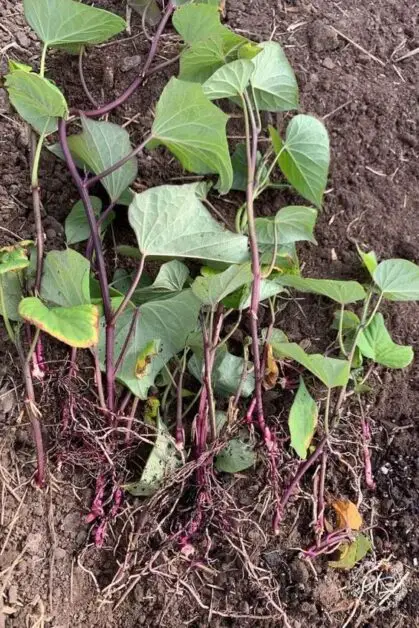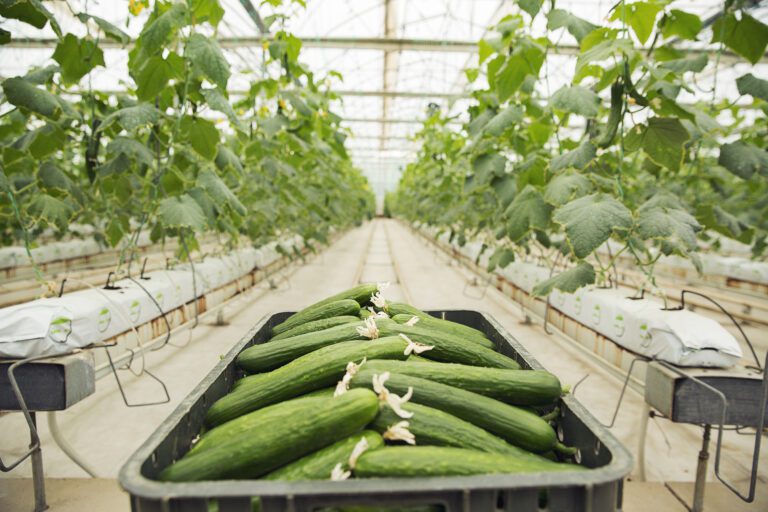How to Grow Stunning Sweet Potato Vines in Your Garden
Table of Contents
Selecting the Right Variety of Sweet Potato Vines
When it comes to selecting the right variety of sweet potato vines for your garden, it’s important to consider several factors. One of the most important considerations is the climate in which you live. Different varieties of sweet potatoes thrive in different climates, so choosing a variety that is well-suited to your local weather conditions will increase your chances of success. Additionally, you’ll want to think about how you plan to use the sweet potatoes. Some varieties are better for baking, while others are better for boiling or mashing. It’s also worth considering the size of the tubers that each variety produces, as this can impact their culinary versatility.

Another factor to take into account when selecting sweet potato vines is their disease resistance. Certain varieties have been bred to be more resistant to common sweet potato diseases, such as Fusarium wilt or root-knot nematodes. By choosing disease-resistant varieties, you can minimize the risk of your plants becoming infected and increase the overall health and productivity of your sweet potato crop. Additionally, some varieties have a better tolerance for drought or poor soil conditions, which can be advantageous if you live in an area with less-than-ideal growing conditions. By carefully considering these factors, you can choose the right variety of sweet potato vine that is best suited to your specific needs and environment.
Preparing the Soil for Sweet Potato Vines
Preparing the soil is a crucial step in ensuring the successful growth of sweet potato vines. The right soil composition provides the optimal conditions for these plants to thrive. To begin, it is important to choose a well-draining soil that is rich in organic matter. Sandy loam or loamy soil is ideal for sweet potato vines as it allows for proper water drainage while retaining enough moisture for the plants.

Before planting, it is recommended to test the soil ph. sweet potato vines prefer slightly acidic soil, with a pH level ranging from 5.8 to 6.2. If the soil pH is not within this range, amendments may be necessary. Adding organic matter, such as compost or well-rotted manure, can help improve soil structure and nutrient content, creating a fertile environment for sweet potato vines.
In addition to amending the soil, it is essential to remove any weeds or grass from the planting area. These unwanted plants can compete for nutrients and hinder the growth of sweet potato vines. Clearing the area before planting will ensure that the vines have ample space and resources to flourish. With the soil properly prepared, you are now ready to move on to the next steps in cultivating vibrant and productive sweet potato vines.
Providing Adequate Sunlight for Sweet Potato Vines
Sweet potato vines are sun-loving plants that require adequate sunlight to thrive and produce a bountiful harvest. As a general rule, sweet potato vines should receive at least 6 to 8 hours of direct sunlight each day. This ensures that the plants receive enough energy for photosynthesis, which is essential for their growth and the development of sweet potato tubers.
When selecting a location for your sweet potato vines, choose an area that receives full sun throughout the day. Avoid planting them in shaded areas or spots that are blocked by tall trees or buildings. If your garden doesn’t have a sunny spot, consider growing sweet potato vines in containers that can be moved to sunnier locations as needed.

It’s worth noting that while sweet potato vines require ample sunlight, they can also tolerate some shade. If you live in a region with intense summer heat, providing a bit of afternoon shade can help protect the plants from scorching and reduce water stress. However, it’s essential to strike a balance and not expose them to excessive shade, as this can result in weak foliage growth and diminished tuber production.
In conclusion, providing adequate sunlight is crucial for the success of your sweet potato vines. Ensure they receive a minimum of 6 to 8 hours of direct sunlight each day and avoid planting them in shaded areas. By meeting this sun requirement, you’ll set your sweet potato vines on the right path towards healthy growth and a plentiful harvest.
Watering Sweet Potato Vines: Best Practices
Watering is a crucial aspect of ensuring healthy growth and bountiful harvests for sweet potato vines. The success of your crops heavily relies on providing the right amount of water at the right time. Over- and under-watering can both have detrimental effects on the overall health and productivity of the plants.
To determine when to water your sweet potato vines, it is important to monitor the moisture levels in the soil. Stick your finger about an inch into the soil and check if it feels dry. If it does, it is time to water your plants. However, be cautious not to overdo it, as sweet potatoes prefer well-drained soil. Aim for about 1 inch of water per week, evenly distributed throughout the plants’ growing season. Adjust this amount based on factors such as rainfall and climate conditions in your region.

When it comes to the watering technique, it is advisable to water the soil directly rather than the foliage. This helps prevent disease and fungal growth, as wet leaves can create a favorable environment for pathogens. Additionally, watering the soil directly ensures that the water reaches the roots effectively, promoting deep root development and improving the plants’ ability to withstand drought. Consider using a soaker hose or drip irrigation system to allow for slow and consistent watering. By adhering to these best practices, you can optimize your sweet potato vine’s water intake and promote healthy growth.
Fertilizing Sweet Potato Vines: Dos and Don’ts
Fertilizing sweet potato vines is an essential step in ensuring healthy growth and a bountiful harvest. However, it’s important to follow the dos and don’ts to avoid any potential harm to your plants. Here are some guidelines to keep in mind when it comes to fertilizing your sweet potato vines.

Dos:
1. Use a balanced fertilizer: When selecting a fertilizer, opt for a balanced formulation with equal or near-equal ratios of nitrogen (N), phosphorus (P), and potassium (K). This balanced approach will provide your sweet potato vines with the necessary nutrients for robust growth and tuber development.
2. Apply fertilizer at planting: Incorporate a slow-release fertilizer or organic amendments into the soil before planting your sweet potato vines. This will ensure a steady supply of nutrients throughout the growing season and help establish strong root systems.
3. Side-dress during the growing season: To provide an additional nutrient boost, side-dress your sweet potato vines with a nitrogen-rich fertilizer approximately four weeks after planting. This will support vigorous foliage growth and encourage tuber development.
Don’ts:
1. Avoid excessive nitrogen: While nitrogen is crucial for leafy growth, an excess of it can hinder tuber formation. Avoid using high-nitrogen fertilizers or applying excessive amounts, as this may result in lush but unproductive vines.
2. Steer clear of phosphorus deficiency: Sweet potato vines have a high phosphorus requirement, especially during early growth stages. Make sure to choose a fertilizer with adequate phosphorus levels to prevent deficiencies and support overall plant health.
3. Refrain from over-fertilization: Over-enthusiastically applying fertilizers can have detrimental effects on your sweet potato vines. Excessive fertilization can lead to nutrient imbalances, nutrient runoff, or even burn the roots, causing plant damage. Properly measure and follow the recommended rates of application to avoid these issues.
By following these dos and don’ts, you can nourish your sweet potato vines effectively and promote optimal growth and yield. Remember to monitor your plants closely, making adjustments as needed based on their specific nutrient requirements. A well-fed sweet potato vine will not only produce an abundance of healthy tubers but also add beauty to your garden.
• Use a balanced fertilizer with equal ratios of nitrogen, phosphorus, and potassium
• Incorporate slow-release fertilizer or organic amendments into the soil before planting
• Side-dress with a nitrogen-rich fertilizer four weeks after planting to boost growth
• Avoid excessive nitrogen that can hinder tuber formation
• Choose a fertilizer with adequate phosphorus levels to prevent deficiencies
• Refrain from over-fertilization to avoid nutrient imbalances and root damage
Planting Sweet Potato Vines: Step-by-Step Guide
To ensure the successful growth of sweet potato vines, it is crucial to follow a step-by-step planting guide. Start by selecting healthy sweet potato plants or slips from a reputable nursery or garden center. These should have well-developed roots and sturdy stems. Before transplanting, it’s important to prepare the soil properly. Sweet potatoes thrive in loose, well-drained soil with a pH range of 5.8 to 6.2. Incorporating organic matter such as compost or aged manure can help improve soil structure and nutrient content.
Next, choose a sunny location for planting sweet potato vines. These heat-loving plants require at least 6-8 hours of direct sunlight per day to grow vigorously. Avoid shaded areas or places with excessive moisture, as this can increase the risk of fungal diseases.

When it comes to actually planting the sweet potato slips, make sure to space them adequately to allow for proper growth and airflow. A spacing of 12-18 inches between each slip is generally recommended. Plant the slips at a depth of around 2-3 inches, ensuring that the soil is firmly pressed around them to establish good contact. Proper spacing and depth will prevent overcrowding and promote healthy root development.
Overall, following these step-by-step guidelines for planting sweet potato vines will set a solid foundation for success. With proper care, these versatile plants can provide a bountiful harvest and add beauty to your garden. Stay tuned for further tips on nurturing your sweet potato vines and ensuring their optimal growth.
Spacing and Depth for Sweet Potato Vine Planting
When it comes to spacing and depth for sweet potato vine planting, precision is key to ensuring healthy growth and optimal yield. Sweet potato vines are vigorous and can spread extensively, so providing them with ample space is essential. The recommended spacing between sweet potato plants is typically 12 to 18 inches (30 to 45 cm) apart within rows, with rows spaced approximately 3 to 4 feet (90 to 120 cm) apart. This allows each plant to have enough room to develop its roots and foliage without crowding or competing for resources.

In terms of depth, the planting hole should be deep enough to accommodate the entire length of the sweet potato vine, with the tip of the vine level with or slightly above the soil surface. A planting depth of around 6 to 8 inches (15 to 20 cm) is generally sufficient. It is important to avoid burying the vine too deeply, as this can hinder its ability to establish roots and lead to poor growth. Additionally, maintaining the proper spacing between plants and rows helps ensure adequate air circulation and sunlight penetration, reducing the risk of disease and promoting overall plant health. By adhering to these spacing and depth guidelines, you can provide your sweet potato vines with the ideal conditions for successful growth and a bountiful harvest.
Mulching Techniques for Sweet Potato Vines
Mulching is an essential technique for maintaining healthy and productive sweet potato vines. By applying a layer of organic mulch around the base of the plants, you can provide numerous benefits that contribute to their overall growth and vigor. One of the primary advantages of mulching is weed suppression. This protective layer acts as a barrier, preventing unwanted weeds from sprouting and competing with the sweet potato vines for essential nutrients and water.

Furthermore, mulching helps to conserve soil moisture by reducing evaporation. Sweet potatoes thrive in moist conditions, and a consistent water supply is crucial for their optimal development. By conserving moisture levels, mulch helps plants stay hydrated, especially during hot and dry periods. Additionally, the organic matter in the mulch slowly breaks down over time, enriching the soil with nutrients. As the mulch decomposes, it releases vital elements, such as nitrogen, phosphorus, and potassium, which are essential for the healthy growth and tuber production of sweet potato vines.
Pruning Sweet Potato Vines: Essential Tips
Pruning is an essential practice for maintaining the health and productivity of sweet potato vines. By removing unwanted growth and encouraging branching, pruning helps to improve air circulation, prevent diseases, and promote better tuber development. The following tips will guide you in pruning your sweet potato vines effectively.
Firstly, it is important to start pruning sweet potato vines once they have established a strong root system and started spreading. This usually occurs around four to six weeks after planting. Begin by removing any damaged or diseased leaves, as well as any dead or wilted stems. This helps to prevent the spread of diseases and promotes the growth of healthy foliage.

Additionally, you should regularly prune the vines to control their growth and promote branching. When pruning, be sure to use sharp and clean pruning shears to make clean cuts. Remove the growing tips of the vines, which will encourage the development of lateral branches and result in a bushier growth habit. Aim to prune the vines every two to three weeks to maintain their vigor and manage their size.
However, it is important to exercise caution when pruning sweet potato vines. Avoid excessive pruning, as this can hinder their ability to produce energy through photosynthesis and reduce overall yield. Also, be mindful of the time of pruning, as it is recommended to avoid pruning during the hottest part of the day to prevent stress on the plants. Following these essential tips will help you maintain healthy and productive sweet potato vines in your garden.
Managing Pests and Diseases in Sweet Potato Vines
Pests and diseases can pose a major threat to sweet potato vines, impacting their growth and overall health. To effectively manage these issues, it is essential to identify and address them promptly. One common pest that affects sweet potato vines is the sweet potato weevil (Cylas formicarius), which can cause significant damage to both the leaves and tubers. Regular monitoring is necessary to catch the early signs of infestation, such as wilting leaves or larvae presence. Infested plants should be promptly removed and destroyed to prevent the spread of the pest.

In addition to pests, it is important to be aware of common diseases that can affect sweet potato vines. Fusarium root rot, caused by the fungus Fusarium oxysporum, can lead to stunted growth and wilting of plants. Prevention is key in managing this disease, as there are currently no effective chemical treatments available. Utilizing disease-resistant sweet potato varieties, practicing crop rotation, and maintaining soil drainage can help minimize the risk of fusarium root rot. Another common disease is Sweet potato virus disease (SPVD), transmitted by the whitefly (Bemisia tabaci). This disease can cause leaf yellowing, vein-clearing, and deformation. Implementing proper pest and whitefly control measures, such as using sticky traps or insecticidal soaps, can help in managing and preventing SPVD.
Harvesting Sweet Potato Vines: Signs of Readiness
Harvesting sweet potato vines at the right time is essential to ensure that you get the best yields and quality from your crop. One of the key signs of readiness is the development of a thick, vine-like structure with sprawling leaves. As the vines grow, they send out runners that anchor themselves to the soil. When these runners start to wilt and turn brown, it is an indication that the sweet potatoes are approaching maturity.

Another visual indicator to look for is the color of the vines. As the sweet potatoes mature, the vines often start to yellow and lose their vibrant green color. This change in color suggests that the energy from the vines is being redirected towards the tubers, promoting their growth and starch accumulation. Observing this phenomenon can help you determine if the roots are adequately developed for harvesting.
However, relying solely on visual cues may not always be sufficient. It is recommended to conduct a gentle “pinch test” to assess the readiness of the sweet potatoes. Using your fingers, carefully press the soil around a few tubers. If the sweet potatoes feel firm and have developed a thick skin, they are likely ready to be harvested. On the other hand, if they feel soft and thin-skinned, it is an indication that they need more time to mature.
Storing Sweet Potato Tubers: Longevity Tips
When it comes to storing sweet potato tubers, following proper techniques can ensure their longevity and availability for extended periods. Sweet potatoes are known for their versatility and nutritional value, making them a popular choice among gardeners. To preserve their quality and taste, it is essential to store them carefully.
One effective method for storing sweet potatoes is to cure them before storing. Curing involves placing the harvested tubers in a warm and humid environment for about 10 to 14 days. This process allows the sweet potatoes to heal any minor cuts or bruises and enhances their sweetness. Ideally, the curing process should take place at a temperature of 80-85°F (27-29°C) with a relative humidity of around 85%. After curing, the sweet potatoes should be stored in a cool, dry, and well-ventilated area. A temperature range of 55-60°F (13-16°C) with a humidity level around 60-70% is ideal for long-term storage. Avoid storing sweet potatoes in areas with high moisture or extreme temperatures, as this can lead to decay or sprouting.

By following these storage tips, you can prolong the shelf life of your sweet potato tubers and enjoy their goodness months after harvest. Proper curing and suitable storage conditions are vital in maintaining their flavor, quality, and nutritional value. However, keep in mind that sweet potatoes are perishable, so it’s essential to regularly monitor them for any signs of spoilage or decay. In the next section, we will explore different methods of propagating sweet potato vines to provide gardeners with even more options for cultivating these delicious and versatile plants.
Propagating Sweet Potato Vines: Methods and Success Rate
Sweet potato vines can be propagated using various methods, with each method having its success rate. The most common method is by using stem cuttings. Select healthy and disease-free vines, and carefully cut about 6 to 8 inches of the stem, ensuring that there are several nodes on the cutting. Remove any leaves from the lower part of the cutting, and dip the cut end in a rooting hormone to promote root development. Plant the cutting in a well-draining potting mix, keeping it moist but not overly saturated. With proper care and monitoring, the success rate of propagating sweet potato vines using stem cuttings is generally high.

Another method of propagation is through the use of small tubers, also known as propagating slips. Once the sweet potato has sprouted small slips, carefully separate them from the main tuber, ensuring that each slip has roots and at least one leaf. Gently plant these slips into prepared soil or containers, making sure to cover the roots with soil and keep them properly watered. The success rate of propagating sweet potato vines using slips is also quite high, as long as the slips are healthy and handled with care during the separation process.
Each of these propagation methods for sweet potato vines offers a reliable means of expanding your garden and increasing your sweet potato yield. Understanding the different methods and their success rates can help you choose the most suitable method for your gardening needs. However, it is important to note that factors such as proper care, environmental conditions, and the health of the parent plant ultimately influence the success rate of propagation.
Troubleshooting Common Issues with Sweet Potato Vines
Sweet potato vines, like any other plant, can sometimes face common issues that hinder their growth and productivity. Gardeners need to familiarize themselves with these problems and their solutions to maintain healthy and thriving sweet potato plants.
One common problem that gardeners may encounter is poor vine growth. This can be attributed to various factors such as inadequate sunlight, improper watering, or nutrient deficiencies in the soil. To address these issues, it is crucial to ensure that sweet potato vines receive at least six to eight hours of direct sunlight each day. Additionally, maintaining a consistent watering schedule and providing the right balance of nutrients through proper fertilization can significantly improve vine growth and overall plant health.
Another issue that may arise is the presence of pests and diseases. Sweet potato vines can be susceptible to pests such as aphids, whiteflies, and nematodes, as well as diseases like stem rot and sweet potato weevils. Conducting regular inspections and implementing preventive measures, such as using organic pest control methods and resistant varieties, can help minimize the impacts of these nuisances. Maintaining good hygiene practices, including removing any infected or damaged vines, is also crucial to prevent the spread of diseases within the garden.
By being attentive to these common issues and implementing the appropriate measures, gardeners can help ensure the successful growth and cultivation of sweet potato vines. Remember to closely monitor the plants, take prompt action when problems arise, and adjust the growing conditions accordingly. With proper care and attention, sweet potato vines can flourish and provide a bountiful harvest for gardeners to enjoy.
Why are the leaves on my sweet potato vines turning yellow?
Yellow leaves on sweet potato vines can be a sign of overwatering or nutrient deficiencies. Make sure you are watering your vines adequately and consider adding a balanced fertilizer to the soil.
How can I prevent pests from damaging my sweet potato vines?
To manage pests on sweet potato vines, regularly inspect the plants for signs of infestation and use appropriate organic insecticides or insecticidal soaps. Additionally, encourage natural predators like ladybugs and lacewings to control pests in your garden.
What are some common diseases that can affect sweet potato vines?
Sweet potato vines can be susceptible to diseases such as sweet potato scurf, root rot, and leaf spot. Proper sanitation, well-drained soil, and avoiding overhead watering can help prevent these diseases.
How do I know when my sweet potato vines are ready for harvest?
Sweet potato vines are typically ready for harvest when the foliage starts to turn yellow and wither. Carefully dig around the plants and harvest the tubers when they reach a desirable size.
Can I store sweet potato tubers for an extended period of time?
Yes, sweet potato tubers can be stored for several months if handled properly. Cure the harvested tubers for a week in a warm, dry environment, then store them in a cool space with good ventilation.
How can I propagate my sweet potato vines?
Sweet potato vines can be easily propagated through stem cuttings. Select healthy stems, remove the lower leaves, and place the cuttings in water until roots develop. Once roots are established, transfer the cuttings to a pot or directly in the garden.
Why are my sweet potato vines not producing any tubers?
Lack of sunlight, improper watering, or nutrient deficiencies can prevent sweet potato vines from producing tubers. Ensure your vines are receiving at least 6-8 hours of sunlight, water them consistently, and provide a balanced fertilizer to promote tuber development.
How often should I prune my sweet potato vines?
Sweet potato vines benefit from regular pruning to control their growth and encourage branching. Prune them every 2-3 weeks, removing any excessive growth or damaged leaves.
Can I grow sweet potato vines in containers?
Yes, sweet potato vines can be grown in containers. Choose a large container with good drainage and use a well-draining soil mix. Place the container in a sunny location and water the vines consistently.
Can I eat the leaves of sweet potato vines?
Yes, sweet potato leaves are edible and can be cooked like spinach or used in salads. They are packed with nutrients and offer a delicious addition to your meals.

Kanike Sreekanth, a prolific writer at SouthElMonteHydroponics, brings a unique blend of creativity and scientific rigor to the table. With a degree in Horticulture from a prestigious institution, Kanike’s expertise spans hydroponic farming, plant biology, and agricultural sustainability. Their passion for exploring innovative cultivation methods and promoting environmental stewardship drives them to uncover new insights in the realm of hydroponics. Kanike’s writing serves as a conduit for sharing their knowledge and inspiring others to embrace alternative farming practices for a more sustainable future.







